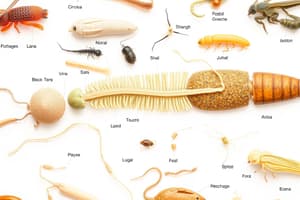Podcast
Questions and Answers
What is classification?
What is classification?
The process of arranging organisms into groups based on similarities.
How does classification help?
How does classification help?
A good classification system can help identify unfamiliar organisms and organize information.
Do the levels of classification become broader or more specific?
Do the levels of classification become broader or more specific?
More specific.
What is taxonomy?
What is taxonomy?
How does taxonomy help?
How does taxonomy help?
What do taxonomists do and why is it important?
What do taxonomists do and why is it important?
What is the difference between taxonomy and classification?
What is the difference between taxonomy and classification?
What are the levels of classification?
What are the levels of classification?
What is a taxon?
What is a taxon?
What is Binomial Nomenclature?
What is Binomial Nomenclature?
What two words make up Binomial Nomenclature?
What two words make up Binomial Nomenclature?
Why are the two organisms Felis Catus and Felis silvestris closely related?
Why are the two organisms Felis Catus and Felis silvestris closely related?
What is a genus?
What is a genus?
What is a species?
What is a species?
Based on Binomial Nomenclature, how can you tell what organisms are closely related?
Based on Binomial Nomenclature, how can you tell what organisms are closely related?
What is a Dichotomous Key?
What is a Dichotomous Key?
What is a Field Guide?
What is a Field Guide?
What is a domain?
What is a domain?
Why did scientists add the classification level Domain?
Why did scientists add the classification level Domain?
What are the six kingdoms?
What are the six kingdoms?
What are the three domains and what kingdoms fall into each?
What are the three domains and what kingdoms fall into each?
Why do certain organisms belong in a specific domain?
Why do certain organisms belong in a specific domain?
What defines the kingdom Animalia?
What defines the kingdom Animalia?
Flashcards are hidden until you start studying
Study Notes
Classification and Taxonomy
- Classification organizes organisms into groups based on shared characteristics.
- Effective classification aids in identifying unfamiliar organisms and streamlining information organization.
Levels of Classification
- Classification levels become more specific with each descending category.
- Sequence of classification levels: Domain, Kingdom, Phylum, Class, Order, Family, Genus, Species.
Taxonomy Explained
- Taxonomy is the scientific discipline of naming and classifying organisms.
- Taxonomists categorize organisms by their characteristics, enhancing communication about them.
Taxon and Binomial Nomenclature
- A taxon is a group of organisms sharing specific traits.
- Binomial nomenclature is a two-word naming system for species, developed by Carolus Linnaeus.
- In this system, the Genus name is capitalized, while the species name is lowercase, both italicized.
Organism Relationships
- Organisms sharing a Genus name are closely related, indicating shared classification levels.
- Examples include Felis Catus and Felis silvestris, both in the same Genus.
Identifying Organisms
- A dichotomous key helps identify organisms through a series of binary questions, narrowing possibilities.
- Field guides classify organisms with photographs and habitat maps.
Domains and Kingdoms
- Organisms are classified into three domains: Eukarya, Bacteria, and Archaea.
- Eukarya includes the kingdoms Animalia, Plantae, Fungi, and Protista; Bacteria and Archaea are separate kingdoms.
- The domain classification emerged from advances in microscopy that revealed three cellular types.
Characteristics and Domain Classification
- Characteristics such as cellular composition, energy acquisition, and nuclear presence determine domain classification.
- Kingdom Animalia includes multicellular and eukaryotic organisms with mobility.
Studying That Suits You
Use AI to generate personalized quizzes and flashcards to suit your learning preferences.




